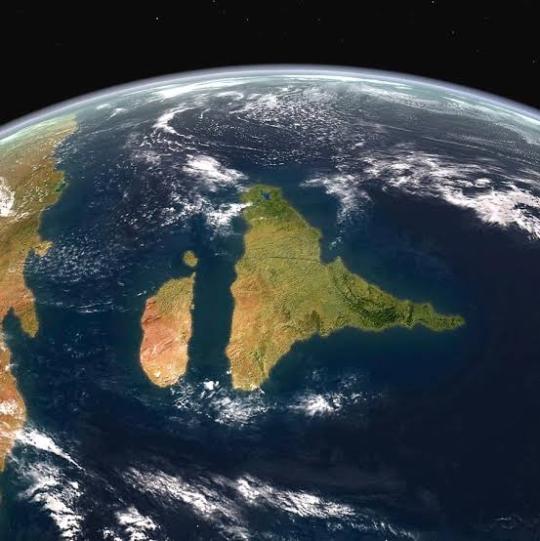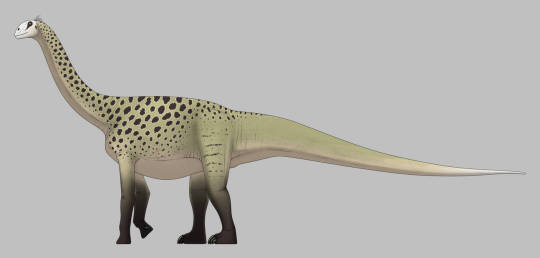#mahajungasuchus
Photo




Flocking Together
Gigatitan
Mahajangasuchus
Corythoraptor
Pederpes
1 note
·
View note
Text
Wednesday 13/10/21 - Dinosaurs of the World Part 4; Madagascar and India

Majungasaurus grabs the tail of a Madagascan crocodilian, Mahajungasuchus; Sergey Krasovskiy
When you think of our current geography, it makes sense to think of Madagascar as part of Africa's greater biosphere; a lot of biota found there now have relatives on the African mainland. The same for India, even more so because the Indian continental plate has made landfall on the Asian Mainland. But in the Mesozoic Period, these two landmasses were more associated with the southern continents of Australia, Antarctica, and South America. India wasn't even a part of Asia until after the dinosaurs went extinct.

Late Cretaceous Madagascar and India, Walter Myers
During the age of reptiles, India and Madagascar were best buddies, and biogeographically, palaeontologists unite these two as their own distinct region. In terms of dinosaur diversity, the two regions share a lot in common with South America. Titanosaur Sauropods and Abelisaur Theropods are king in these regions. So when I started to construct a list of dinosaur highlights, I found it difficult to make a list of dinosaurs that weren't all Sauropods and Abelisaurs. So compared to my Africa, and Asia episodes, this list will be a bit shorter, but rest assured, there is a lot to discover about dinosaurs from Madagascar and India.
Isisaurus colberti

Isisaurus, Dmitry Bogdanov
Isisaurus was a large sauropod from Late Cretaceous India. It was a member of the Titanosaur clade, the largest and longest, and heaviest of all dinosaurs. Isisaurus colberti was originally called Titanosaurus colberti, united with the Indian dinosaur that this clade is named after, but closer inspection of its fossils led palaeontologists to classify Isisaurus in its own genus. Titanosaurus itself is currently a nomen dubium: a species that may not be real because remains are too fragmentary to be sure.
The most distinguishing feature of Isisaurus is its tall neck spines, giving it a very unique appearance for a Titanosaur, but it's not really known why they had them. Isisaurus coprolites (fossil poo) have had parts of pathogenic (diseasing) fungus found in them, giving paleobotanists a unique insight into the plant life of its habitat. Isisaurus is also unique in its name. It does not in fact call reference to the Egyptian God Isis, but it is fact named for the ISI (Indian Statistical Institution), making the only dinosaur I personally know to be named after an acronym.
Barapasaurus tagorei

Barapasaurus, SpinoInWonderland (deviantart)
Barapasaurus was an Early Jurassic Sauropod from central India. It was very early for a Sauropod, evolutionarily, but quite large for its time, 5.5 m tall and 14 m long. It's skeleton reveals a lot of traits basal to the true sauropod group, but was primitive in others, particularly its feet. Barapasaurus was the first dinosaur skeleton to be mounted in an Indian Museum, in 1977. It's name is also part Indian (Bengali), Bara meaning "Large", and Pa meaning "Leg" and of course the Greek Saurus to end it out. The large leg bone in question being the first bone of the animal found.
Dravidosaurus blandfordi

Dravidosaurus, Pavel Riha
Dravidosaurus was (potentially) a late surviving Stegosaur found in Late Cretaceous India. So far in these lists, I've tried to avoid highlighting Nomen Dubium, but I wanted a bit of variety in my Indian Dinosaurs, so this is an exception. Dravidosaurus is named for the Dravidanadu region of South India where it was found. Studies of the specimen in the 1990s hypothesised it was a plesiosaur, a type of marine reptiles related to turtles. But studies in the 2010s decided that among the remains found are a Stegosaur back plate and tail spike, but there's still too little material to be sure of anything. If it was indeed a Stegosaur, it was one of the smallest, 3 metres long and maybe half a metre tall.
Rahonavis ostromi

Rahonavis, Julio Lacerda (@paleoart on tumblr)
Rahonavis was a small theropod dinosaur from Late Cretaceous Madagascar. It's exact classification has been subject to much debate since it was first described, as it lies right on the boundary between non-avian dinosaurs and the earliest true birds. Depending on who you ask, Rahonavis is either a basal Avialan like Archaeopteryx, or an extremely derived dromeosaur like Dakotaraptor or Microraptor. Given the shape of its arms, and the evidence of flight feathers, Rahonavis was likely capable of flight, but wasn't as good in the air as modern birds. It was the size of a typical modern bird too, about 70 cm long. It's name consists of the Malagasy Rahona, meaning "Cloud/Menacing" and the Latin Avis, meaning "Bird".
Majungasaurus crenatissimus

Majungasaurus, Moonmelo (deviantart)
Majungasaurus was a medium sized Abelisaur theropod from Madagascar. It was from the very end of the Cretaceous period, one of the last dinosaurs. Majungasaurus was about 3 m tall and 8 m long. It had one of the most complete skull fossils of its family, with a blunt snout, sturdy, but wrinkled face structure, and its signature cone shaped horn right between its eyes. The horn was not built for combat and would've likely been a display structure. Its short but robust jaw allowed Majungasaurus and other Abelisaurs to bite down and twist more effectively than other theropods, and may have been specialised for hunting the many Sauropod species that inhabited Madagascar in its time. Majungasaurus is named for the Mahajunga province of North Madagascar.
The unique horn shape may be the most visual diagnostic feature of Majungasaurus, but many actually know the dinosaur for being the only non-avian dinosaur to have evidence of cannibalism. Signature bite marks found in Majungasaurus prey has also been found in other adult and juvenile Majungasaurus specimens. Palaeontologists are unsure if this is evidence of Majungasaurus actively hunting other members of its species, or if they simply scavenged on the dead.
Thanks for Reading
I apologise for making this article a bit shorter than the last couple has been. I've been trying to include some variety in dinosaur clades in these regional highlights, so rather than discuss mostly Abelisaurs and Titanosaurs, I picked one of each and then a few more notable species I could find. There really are a lot of interesting species from both India and Madagascar, so I recommend looking up info on the other interesting dinosaurs from the regions.
Next blogpost I'm thinking Europe, and there's quite a few interesting species I can think of already without consulting the entire list of species. My intention is to do North America last, since most of the species people know are from there and I want my readers to savour what the rest of the world has to offer first. As usual, links to previous and future articles below, and will be edited once I have written more.
<< Part 3: Africa || Part 5: Europe >>
#blog#blogpost#palaeontology#dinosaurs#indian dinosaurs#madagascan dinosaurs#isisaurus#barapasaurus#dravidosaurus#rahonavis#majungasaurus
37 notes
·
View notes